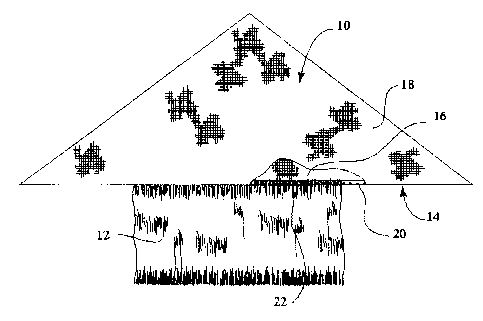Some of the information on this Web page has been provided by external sources. The Government of Canada is not responsible for the accuracy, reliability or currency of the information supplied by external sources. Users wishing to rely upon this information should consult directly with the source of the information. Content provided by external sources is not subject to official languages, privacy and accessibility requirements.
Any discrepancies in the text and image of the Claims and Abstract are due to differing posting times. Text of the Claims and Abstract are posted:
| (12) Patent: | (11) CA 2735848 |
|---|---|
| (54) English Title: | WEFT-BEARING BABUSHKA WITH HIDDEN CONNECTION |
| (54) French Title: | FICHU PORTANT UN TISSAGE DE CHEVEUX A FIXATION CACHEE |
| Status: | Expired and beyond the Period of Reversal |
| (51) International Patent Classification (IPC): |
|
|---|---|
| (72) Inventors : |
|
| (73) Owners : |
|
| (71) Applicants : |
|
| (74) Agent: | OYEN WIGGS GREEN & MUTALA LLP |
| (74) Associate agent: | |
| (45) Issued: | 2015-11-24 |
| (86) PCT Filing Date: | 2009-08-31 |
| (87) Open to Public Inspection: | 2010-03-18 |
| Examination requested: | 2013-08-21 |
| Availability of licence: | N/A |
| Dedicated to the Public: | N/A |
| (25) Language of filing: | English |
| Patent Cooperation Treaty (PCT): | Yes |
|---|---|
| (86) PCT Filing Number: | PCT/US2009/055531 |
| (87) International Publication Number: | WO 2010030526 |
| (85) National Entry: | 2011-03-02 |
| (30) Application Priority Data: | ||||||
|---|---|---|---|---|---|---|
|
A two ply head covering in the form of a triangular scarf or babushka in which
a weft of hair is secured to extend
directly from the front edge of the babushka between opposing inturned forward
edges of the babushka.
Couvre-chef à deux plis prenant la forme dun foulard ou dun fichu triangulaire dans lequel un tissage de cheveux est fixé de manière à sétendre directement à partir du bord frontal du fichu entre les bords opposés intérieurs avant du fichu.
Note: Claims are shown in the official language in which they were submitted.
Note: Descriptions are shown in the official language in which they were submitted.

2024-08-01:As part of the Next Generation Patents (NGP) transition, the Canadian Patents Database (CPD) now contains a more detailed Event History, which replicates the Event Log of our new back-office solution.
Please note that "Inactive:" events refers to events no longer in use in our new back-office solution.
For a clearer understanding of the status of the application/patent presented on this page, the site Disclaimer , as well as the definitions for Patent , Event History , Maintenance Fee and Payment History should be consulted.
| Description | Date |
|---|---|
| Time Limit for Reversal Expired | 2018-08-31 |
| Letter Sent | 2017-08-31 |
| Grant by Issuance | 2015-11-24 |
| Inactive: Cover page published | 2015-11-23 |
| Inactive: Final fee received | 2015-08-18 |
| Pre-grant | 2015-08-18 |
| Notice of Allowance is Issued | 2015-02-26 |
| Letter Sent | 2015-02-26 |
| Notice of Allowance is Issued | 2015-02-26 |
| Inactive: Approved for allowance (AFA) | 2015-01-21 |
| Inactive: Q2 passed | 2015-01-21 |
| Amendment Received - Voluntary Amendment | 2014-11-24 |
| Inactive: S.30(2) Rules - Examiner requisition | 2014-10-27 |
| Inactive: Report - No QC | 2014-10-21 |
| Amendment Received - Voluntary Amendment | 2013-09-26 |
| Letter Sent | 2013-08-29 |
| Request for Examination Requirements Determined Compliant | 2013-08-21 |
| All Requirements for Examination Determined Compliant | 2013-08-21 |
| Request for Examination Received | 2013-08-21 |
| Inactive: Cover page published | 2012-09-10 |
| Inactive: IPC assigned | 2011-04-15 |
| Inactive: IPC assigned | 2011-04-15 |
| Inactive: IPC assigned | 2011-04-15 |
| Application Received - PCT | 2011-04-15 |
| Inactive: First IPC assigned | 2011-04-15 |
| Inactive: Notice - National entry - No RFE | 2011-04-15 |
| Inactive: Inventor deleted | 2011-04-15 |
| Inactive: IPC assigned | 2011-04-15 |
| National Entry Requirements Determined Compliant | 2011-03-02 |
| Small Entity Declaration Determined Compliant | 2011-03-02 |
| Application Published (Open to Public Inspection) | 2010-03-18 |
There is no abandonment history.
The last payment was received on 2015-06-16
Note : If the full payment has not been received on or before the date indicated, a further fee may be required which may be one of the following
Please refer to the CIPO Patent Fees web page to see all current fee amounts.
| Fee Type | Anniversary Year | Due Date | Paid Date |
|---|---|---|---|
| Basic national fee - small | 2011-03-02 | ||
| MF (application, 2nd anniv.) - small | 02 | 2011-08-31 | 2011-03-02 |
| MF (application, 3rd anniv.) - small | 03 | 2012-08-31 | 2012-06-21 |
| MF (application, 4th anniv.) - small | 04 | 2013-09-03 | 2013-06-17 |
| Request for examination - small | 2013-08-21 | ||
| MF (application, 5th anniv.) - small | 05 | 2014-09-02 | 2014-06-16 |
| MF (application, 6th anniv.) - small | 06 | 2015-08-31 | 2015-06-16 |
| Final fee - small | 2015-08-18 | ||
| MF (patent, 7th anniv.) - small | 2016-08-31 | 2016-07-14 |
Note: Records showing the ownership history in alphabetical order.
| Current Owners on Record |
|---|
| KEELA F. CASTLE |
| Past Owners on Record |
|---|
| None |